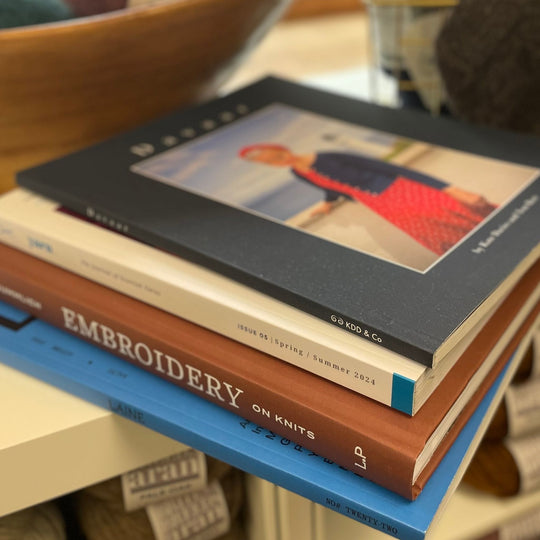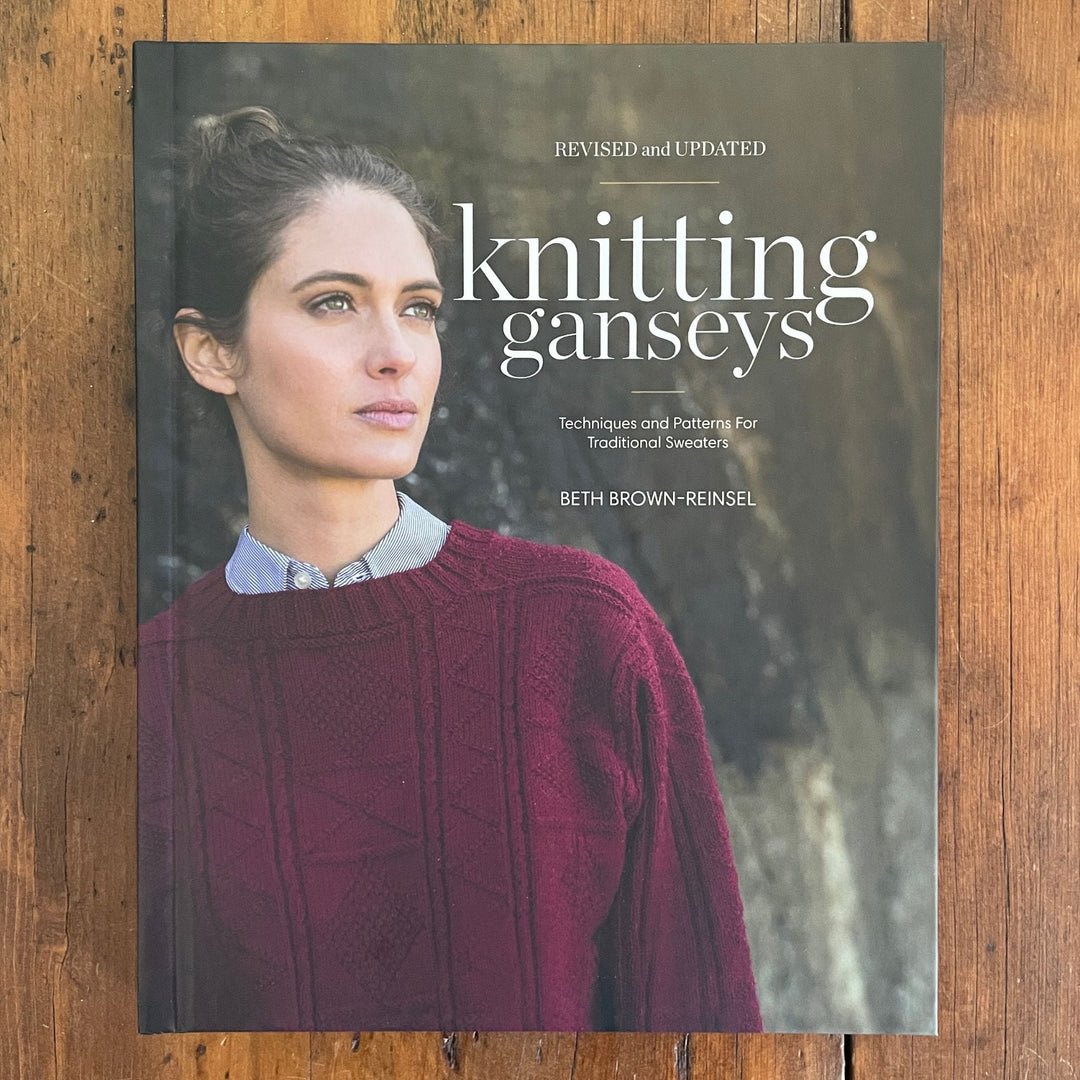
Aiming for Drape: How to Choose Yarns for Drapey Fabric

Topic Favourite
Frangipani 5-ply Guernsey Wool Yarn
With our Shawl Knit-Along coming up soon, perhaps you’re considering your options when it comes to shawl shapes, colors, and yarns. Today we want to offer some ideas for choosing the right yarn and pattern for your shawl, especially if you’re aiming for something with drape that you can easily throw across the shoulders. Let’s jump further into what might give a shawl drape and how to choose a yarn and pattern to get the fabric you want.
What is Drape?
In general, drape is the opposite of elasticity. A drapey fabric will hang loosely and gently, with a flowy character to it. Drape has a lot to do with how the fibers interact with each other, and then how the stitches in knitted fabric interact with each other.
Main Factors that Affect Drape
These are just general things to keep in mind. Each yarn will have its own characteristics, which is part of the fun of swatching and getting to know how a yarn behaves! There’s nothing quite like getting a yarn on your needles (and then blocking it!) to really get the feel for it, but when shopping online it might be helpful to keep these things in mind:
- Fiber Content: Cellulose fibers (cotton, linen) are generally drapey, as are alpaca, silk, and mohair. Polyester lands somewhere in the middle of the drape spectrum. Wool depends on the breed - longwools are generally drapier than fine wools. Long locks and waves of wool are drapey, short fine and crimpy are elastic.
- Prep and Spinning style: Smooth tends to be drapey, fuzzy is elastic. Worsted spun is drapey, woolen spun is elastic. Superwash wool is drapey, untreated wool is elastic. When fibers can easily slip past each other and are straightened into a dense, smooth prep, they’ll have more drape.
- Ply number: Single or two ply is drapey, more plies is elastic
- Ply twist: Loosely plied is drapey, tightly plied is elastic
- Knitted Fabric: Loose gauge is drapey, tight gauge creates a more rigid fabric.
- Type of fabric: lace and stockinette will be drapey, cables and colorwork more rigid.
Yarn Examples
Let’s look at a few specific yarns as an example. A tightly spun wool yarn like Frangipani is usually knit at a tight gauge - this creates indestructible and water-repellent fishermen’s sweaters. This fabric will be dense and more structured, not drapey at all.

On the other end of the drape spectrum, here is a skein of my handspun. It’s a loosely spun two-ply suri alpaca with worsted prep and spinning. I can’t think of anything with more drape. Knitted into a lace or loose gauge, it might even be unbearably drapey, so slippery and loosely knitted that the fabric becomes hard to work with!
Drapey Yarns from TWT
Here are a few examples of yarns from The Woolly Thistle with the potential for some awesome drape.
Jaggerspun Heathers: This worsted spun yarn is so pretty and glows with its sheen and mix of colors. Not very tightly plied, this yarn has great drape potential at a fingering weight!
Rauma Tumi: If you’re a Rauma fan already, give Tumi a try! The added alpaca content will give it some drapiness and also a bit of halo and shine.
Wensleydale longwool: Just looking at a Wensleydale sheep will tell you its wool will make nice drapey yarn! The long wavy fibers give these yarns more drape, but it’s still prepared in a way that keeps it feeling soft.

John Arbon Devonia or Appledore DK: John Arbon Mill is a worsted style spinning mill that makes fabulous yarns with some smoothness and shine like Devonia, Appledore, and Marie Wallin British Breeds. Their yarns are pretty custom blends of sheep breeds to aim for balanced yarns that are soft, strong, and a nice combo of drape and bounce.
Add some Mohair!
If you’re looking to increase the drape of a yarn you already love, think about adding a strand of silk mohair! Holding the yarns together will allow you to push the gauge looser and the silk and mohair add shine, strength, and drape! Corinne’s Vanilla Fluff sweater does this beautifully with Rauma Finullgarn and Plum. Biches et Buches Le Petit Lambswool already has some nice drape, and holding it with some of their silk mohair would be a lovely experience!
Other TWT Yarns with Drape Potential
What about all the other yarns at The Woolly Thistle? Well, what’s great about most of our yarns is that they seem to be engineered to have the best of both worlds. They combine both drapey and elastic characteristics for yarns that are incredibly versatile for a number of projects! Here are a few examples:
It’s tightly spun and several plies, but superwash to create something that feels like elastic cotton. It has nice drape while still being easy on the hands! Sturdy at a tight gauge for socks but drapey at a looser gauge.
Shetland yarns & Norwegian yarns
J&S 2ply jumper weight and Rauma Finullgarn come to mind. These are woolen spun crimpy wool, but in a loose two-ply means it can be versatile depending on gauge.
Gudrun Johnston’s Hansel Hap is a great example of the wonderful drape you can get with J&S 2ply. It’s knit on size 8 needles and squishy garter and lace! In contrast, something like Corinne’s Flowers of Fortrose hat is thicker colorwork fabric, knit on size 4 needles for a much denser and firmer fabric.
Lopi
Lopi yarns like Lettlopi (loosely spun) and Plotulopi (unspun) are a bit of a puzzle when it comes to drape. They’re essentially one ply, with a mix of short and long fibers. It also has a fuzzy feel and noticeable halo. These characteristics make Lopi incredibly versatile when it comes to gauge. Knit it super tight for the warmest mittens ever. Or knit Lettlopi on big needles for a drapey sweater like the Felix!
I hope this gives you some helpful tips about yarn characteristics! In general, when aiming for drape in a shawl, push your yarn towards the looser gauge rather than tighter. Choose yarns that are the weight called for, or a slightly finer gauge rather than heavier. If using a heavier yarn than called for, bump up the gauge and expect a bigger shawl and to use more yarn. Also, look for patterns that include lace, stockinette, or garter. Happy shawl knitting!
Don’t forget to sign up for our upcoming Shawl Knit-Along! Our communities will be knitting together to inspire, cheer, and learn about shawl and hap making, and we hope you’ll join us!
4 comments
Back to The Woolly Thistle











































I would like to sign up for the early access 2023 TWT selection box .
Thank you so much – this isa so helpful. Great to see the examples of yarns specifically!
Wonderful review, thank you so very much. ❤️🧶❤️
Thanks for this post. Some guidelines I had figured out, but the term elastic is helpful to keep in mind versus drapy when looking for drape. Examples of TWW yarns are helpful, too.
Leave a comment